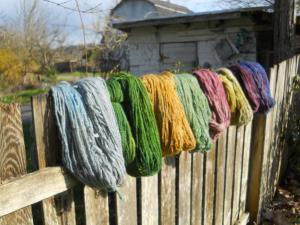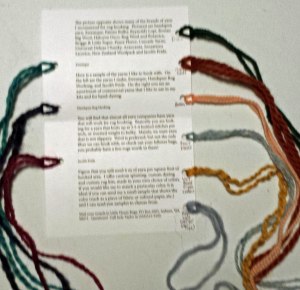
What yarns work best for rug hooking?
Basically any yarn that is a worsted weight-bulky will work well for rug hooking, as long as it is not slippery. If you are looking at a label, any yarn that knits 3.5-4 knitted stitches per inch is great. Wool is just plain wonderful, but lots of other fibers hook up well, again, as long as they are not slippery. Figure that you will need around 4 oz of yarn per square foot of hooked area.

I make three different yarns that work well for rug hooking. Ewenique is a blend of fibers from our farm (65% Jacob wool, 35% adult mohair), Jacob’s Pride is a worsted-weight yarn that is 100% Jacob.
Handspinning yarn is a great way to design yarns with the exact features you want, such as thickness, texture, colors and fiber types. I do custom handspinning, but you can also check out spinning guilds in your area.

Handspun yarn is a great way to incorporate natural colors in your rugs. There is an amazing variety of breeds of sheep, fleece types and colors. This is a feature that is simply not available when hooking with fabric strips, and is something that I really enjoy in my rugs.


This rug was hooked using the above natural-colored yarns
That being said, while I go through a ton of the above yarns, I also consume vast amounts of other brands. Halcyon Yarn (a mail order yarn company, also online) has three yarns that I love; Deco, Rug Wool and Botanica. Deco and Botanica are both worsted weight, Rug Wool is bulky.

Basically any yarn company will have a variety of weights, so look for their worsted/bulky offerings. Some of the brands I like are Patons Bulky, Reynold’s Lopi (lopi yarns are single ply yarns, lovely to work with, but not my first choice for floor rugs, not as durable as a plied yarn), Rowan Big Wool, Briggs & Little Super and Atlantic, Peace Fleece, Cascade Yarns,
Universal Deluxe Chunky, Araucania, Sensations Licorice, Lion’s Pride Organic Cotton, Blackberry Ridge, New Zealand Woolpack. I am always on the lookout for sales. (And by the way, Knitpicks.com is having a sale on wool yarns in worsted weight and bulky. I haven’t yet tried those brands but they look lovely!).
And one of the best sources of yarn is your very own stash! You have one, admit it. All those leftovers from knitting or crochet, or weaving, or macrame, whatever. All those gorgeous yarns you bought because you simply had to have them, regardless of what you might do with them. These are some of the most fun yarns to work with, because you can do such whimsical hit-or-miss designs.



Do yourself a favor, take out all those leftovers, all those yarn purchases and get them out where you can see them. Organize them by color, so color planning your project is a breeze. This will take up some space in your home studio, but it is so helpful. Every time I walk into my workroom, I feel inspired, like I get to ‘go shopping.’

The Featured Rug of the Month at http://www.littlehouserugs.com this month is a super easy hit or miss design, called Velkommen (Norwegian for ‘welcome’). Any and all of your leftover yarns will work great for this design, and it’s an easy way to get the hang of rug hooking.
Subscribers to this blog can get 30% off on Vilkommen kits and patterns at http://www.littlehouserugs.com/velkommenspecial.html.
Next topic: Which backing is best for rug hooking?
Thanks for this information I’m a yarn hooker have used mainly Briggs& Little brands. Have added others that have caught my eye so getting a pretty good stash for a newbie . I have a bulky wool that I’m not too sure where to use it but willing to try it out , again thx look forward to following your posts
LikeLike
Thank you so much for posting on this subject! I was under the impression you could only use wool! This takes some of the stress out when planning my future rugs….:)
LikeLike
Thanks for starting this blog, Judy. About a year and a half ago I switched to using mostly yarn in my hooking. My hooking friends use wool strips (beautifully!), but I am really glad to be receiving inspiration from you for working with yarn!
LikeLike
I’m very much looking forward to following your blog.
Thank you for sharing.
LikeLike
If you didn’t get my email, you could try your junk mail? I did send your package on Monday 2/23/15. It should arrive in three weeks, or maybe sooner. They didn’t give a tracking number, but I did email you a customs form number, don’t know if that helps.
LikeLike
Is the method the same when using yarn as when using wool! Yarn seems to come undone easier than wool
Thank you
LikeLike
The method is similar, we use the same hook and we make loops, but with yarn, you don’t have to worry about it twisting across the back or getting frayed with too much up and down motion, which actually allows you to go quite a bit faster. Interestingly, you can go without the frame with yarn if you like, which is nice if you’re going to a meeting or something, you can just wrap the backing around your legs.
There are many things you can do with yarn, texture, color, blending of fibers, etc. that are not available with strips, and that can add a lot to your projects. And there has never been a time when so much fantastic yarn has been available in every color, style, texture you can imagine.
As far as the yarn coming undone, it doesn’t appear to me to make much difference (I have about a dozen hooked rugs in my house, hooked with both yarn and fabric strips, and they both hold up very well.). I will say, though, that it is much easier to re-hook or repair yarn hooked rugs if they do get stained or pulled. But of course, you can see I am biased. I always encourage my students to try it all, yarn, fabric strips, even punch hooking, because whichever method or fiber you choose, it’s all about your creativity. You are going to be spending hours and hours doing it, so you must find the approach you like the best, or combine them all!
LikeLike
Which yarn is better for hooking, acrylic or wool? I’ve been using acrylic and the yarn pulls out very easily. It’s difficult to find 100% wool in stores near me. P
LikeLike
There are so many different types of acrylics now, just look for yarns that have a bit more texture to them. If you can’t get yarns locally, try the internet. I really like Halcyon Rug Wool, Deco and Botanica, also Peace Fleece, Cascade Ecological, as well as many others. Wool yarns are great, but some cotton yarns work well too, like Lion Brand Nature’s Choice Organic Cotton, Universal Yarn Cirrus Cotton and Lily Cotton Sugar & Cream. Check the knitting gauge, a yarn that knits up 3.5-4 knitted stitches per inch works well for rug hooking. I do lots of my own yarn, handspun, Rustic Rainbow and Jacob’s Pride (both 100% wool) and Ewenique (65% jacob/35% mohair). I can dye whatever colors you like. On my website, you can order samplers which are 1.5 oz of yarn in three colors. Enough for you to try hooking with them to see if you like them.
LikeLike
thank you for all the information on yarns for hooking. I am getting ready to start my first hooking project. I am going to use yarn.
LikeLike
I am allergic to wool, and looking to buy an alpaca fleece and hand-spinning it for rug wool, as the “rug wool” commonly available in alpaca is super-bulky 3/9 to 1/2 in in diameter and made for weaving. What characteristics in terms of fleece make the best rug yarn? I’m assuming the coarser (stronger) the fleece, the better, but what about staple length? And would you advise core-spinning (with a very thin tencel core) alpaca for your rug wool, or blend it with nylon or tencel for strength and do it in plies?
LikeLike
Very interesting question. I have hooked with alpaca. It worked pretty well, but be aware that it can be slipperier than wool. Coarse fibers are ideal for rug making, but I think that perhaps has more to do with saving softer fibers for clothing, where you will appreciate the softness. In my opinion, merino or shetland wool is just as durable in terms of wear and tear on the floor, it just seems like a waste to put it on the floor. That being said, I don’t doubt alpaca would make a durable rug yarn. Not sure you would need the tencel core (although it wouldn’t do any harm at all). I would concentrate on bulking the alpaca up, either by spinning thicker plies or with more plies. I’d love to hear about what you come up with.
LikeLike
Super new to yarn crafts here, I would like to vary the textures in my latch hook wall hanging, and considering buying a 6-super bulky yarn for some areas. Is that going to be workable? Canvas is 3.75 holes per inch.
LikeLike
I’m not an expert on latch-hooking, but it sounds interesting. Give it a try and let me know how it works out.
LikeLike
You don’t mention which ply..I want to make a floor rug using a hook
LikeLike
Plied yarns are more durable than single ply, so better for floor rugs. As to how many plies, when I spin, I do a 2 ply, but most of the commercial yarns I hook with are 3 ply. They are worsted weight to bulky yarns. If you are looking at a knitting gauge on the label, that means 3.5-4 knitted stitches per inch. I hope that helps!
LikeLike
Hi Judy…I’m rug hooking on a rug canvas….does this change the size or thickness of yarn that one uses hooking on a “rug canvas”?. I’m a rookie and new to this rug hooking craft although I’ve ben weaving on a rug loom for over 3 years. The technique seems different if one is using “monks” cloth,. Do those techniquea and rules apply to rug hooking on “canvas”… ????
LikeLike
Depending on how tight the weave of the fabric, you might need a narrower hook (2mm or smaller) so you’re not fighting the backing to make your loops. Other than that, the technique is the same. Really bulky yarns might be difficult to pull through a tight weave fabric, but worsted weight should do great.
LikeLike
Hi Judy
I’m hooking using 80/20 carpet yarn. The company in UK I was buying from has closed. Any suggestions? Ta
LikeLike
I’d try Halcyon Yarn, either Deco or Rug Wool?
LikeLike